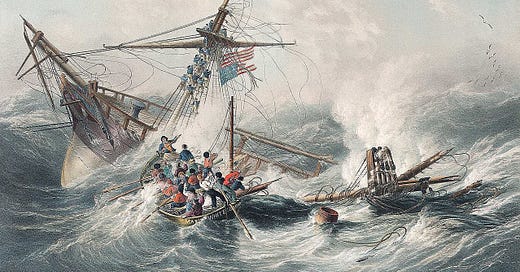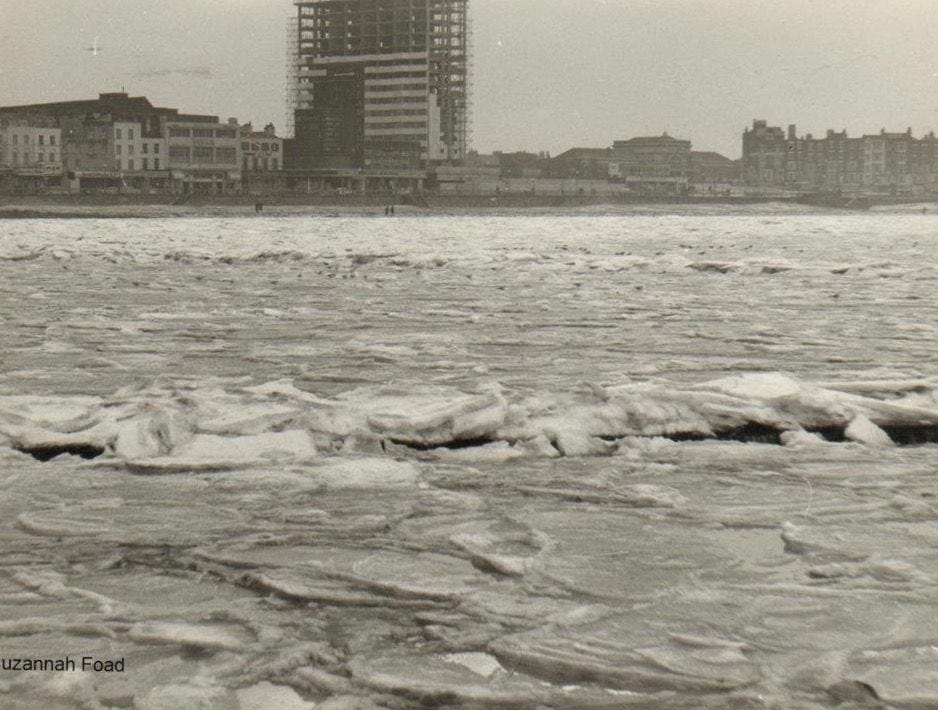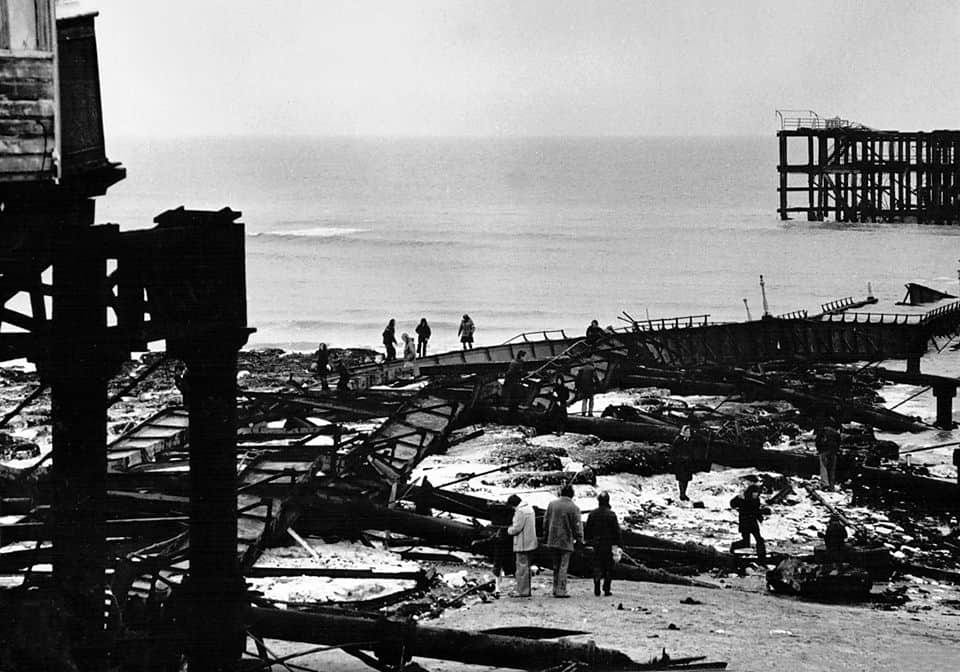Margate in January: Ice, Storms, and Unsinkable Spirit
Frozen seas, daring rescues, and stormy legends—Margate's winter tales unfold."
Over the years, Margate has been the stage for some pretty memorable events—tragic, quirky (think freezing-over-the-harbor weird), and even deeply spiritual. Speaking of spiritual, just last weekend, the local Greek community gathered for the annual Blessing of the Sea on January 5.
This year marks the 60th anniversary of the Greek Orthodox Church's presence in Margate—a tradition steeped in faith and brought here thanks to the vibrant Greek Cypriot community that made Margate home in the mid-20th century. It’s a celebration of Epiphany, commemorating Christ’s baptism, and the event is as visually striking as it is meaningful.
Led by the community of the Archangel Michael, the Archbishop presides over the ceremony with prayers, a symbolic dove release, and the highlight: a decorated cross hurled into the sea, only to be bravely retrieved by a young diver. Now that’s dedication—both spiritual and physical!
Tragedy and Heroism: The Northern Belle and the Loss of the Victory
On January 5, 1857, the American barque Northern Belle, en route from New York to London with a cargo of wheat, flour, and linseed cake, encountered a severe gale that forced her to seek refuge near Kingsgate, Kent. Anchored three-quarters of a mile from shore, the vessel endured relentless seas that eventually led the crew to cut away the main and mizzen masts in an attempt to stabilize her.
In response to the distress, Margate's maritime community dispatched three luggers: Victory, Ocean, and Eclipse, aiming to assist the imperiled crew. Tragically, at approximately 11:30 am, the Victory capsized amid the tumultuous seas, resulting in the loss of all nine crew members: John Smith, William Emptage, Isaac Solly, Abraham Busbridge, Charles Fuller, John Emptage, George Smith, Henry Paramore, and Frederick Bath.
The storm persisted, preventing immediate rescue operations. By midnight, the Northern Belle had parted from her anchors and was driven onto the rocks at Foreness Point. At dawn, the stranded crew was spotted clinging to the remaining mast. Demonstrating remarkable determination, the lifeboats Mary White and Culmer White, manned by crews from Broadstairs and Margate, executed three perilous trips to rescue all aboard. Notably, the Mary White had to be hauled two miles over snow-covered fields to reach a suitable launch point.
The loss of the Victory and her crew profoundly impacted the Margate community, underscoring the perilous nature of maritime rescue operations. This tragedy catalyzed the establishment of a dedicated surfboat service in Margate, enhancing the town's capacity to respond to maritime emergencies. The first surfboat, named Friend of All Nations, was introduced shortly thereafter. Although it was wrecked in 1860, it returned to service until 1877. Its successor, also named Friend to All Nations, continued the legacy, despite facing its own tragedies, including the loss of nine crew members during a storm in 1897.
In recognition of the bravery displayed during the Northern Belle rescue, U.S. President Franklin Pierce commissioned 21 silver medals and awarded £270 sterling to be distributed among the rescuers, with individual amounts ranging from £10 to £30. Today, the heroism of the Victory crew is commemorated by a marble memorial set into the wall of Margate's jetty, serving as a lasting tribute to their sacrifice.
Image shows the Mary White life boat rescuing the crew of the American Ship the Northern Belle Hand-coloured lithograph, after a painting by James Wilson Carmichael. The Mary White lifeboat rescuing the crew of the American ship the Northern Belle
There used to be several pubs in and around the town that were named as nods to the maritime stories associated with the area. Many of these have now disappeared, but the Northern Belle pub, said to be Margate's oldest, still stands.
Probably Margate's oldest pub, the Northern Belle, may date from 1640, but incorporates timber from the wreck whose name it bears.
Formerly the "Waterman's Arms" and was renamed in 1857 after the wrecking of the "Northern Belle."
The "Northern Belle" is supposedly haunted by the whispy white form of a woman in a veil or shroud who has been seen many times over the centuries drifting through the cellars, bars and rooms above the pub.
Taken from Dover Kent Archives
When the Sea Froze Over: Winter of 1962-63
The winter of 1962-63 stands out in British history as one of the coldest on record, with temperatures plummeting to -20°C (-4°F). This severe cold snap had a profound impact on coastal towns like Margate, where the sea itself began to freeze—a rare and striking phenomenon.
Photographs from January 1963 vividly capture the frozen seafront of Margate, with ice extending from the beaches into the sea. These images depict a surreal landscape where the familiar ebb and flow of the tides were halted by sheets of ice, creating an otherworldly scene for residents and visitors alike.
The extreme cold not only transformed the seascape but also had significant ecological impacts. Marine life suffered as the freezing temperatures disrupted habitats, leading to the death of many shore crabs and other sea creatures. The local flora was similarly affected, with seaweed and algae stripped from the rocks, leaving them blanched white—a stark reminder of nature's vulnerability to sudden climatic shifts.
This extraordinary event is still remembered by long-time residents of Margate and the surrounding areas. The sight of a frozen sea remains a topic of local lore, symbolizing both the harshness of that winter and the resilience of the community in the face of nature's extremes.
Image shows margate main sands frozen
Image Suzannah Foad
The Storms of 1808 and 1978
The Storm of 1808
The storm of 1808 was one of the fiercest on record for its time, wreaking havoc across the Kent coastline. Margate, with its prominent position along the English Channel, bore the brunt of the tempest. Ferocious winds and towering waves battered the town, damaging numerous buildings and sweeping small vessels ashore.
One of the storm’s most tragic episodes occurred when several ships anchored near Margate were caught in the gale and driven onto the Goodwin Sands—a notorious graveyard for ships. Despite valiant efforts by the local community to save those onboard, many lives were lost, and the wreckage was a grim reminder of nature’s fury.
View of Margate during the storm in 1808. Drawn and aquatinted by J. Hassell, circa 1808.
The Storm of 1978
Fast-forward to January 1978, and Margate once again faced the fury of nature with the Great Storm. This storm was part of a larger weather system that caused devastation across the UK. Margate suffered widespread flooding as high tides combined with gale-force winds overwhelmed the town's sea defences.
The flooding was so severe that parts of Margate's Old Town were submerged, with residents and businesses forced to evacuate. The iconic Margate Harbour and Turner Contemporary site were engulfed by water, and the storm caused significant damage to coastal infrastructure. Power outages and disruptions to transport further compounded the chaos.
Local efforts to rebuild after the storm were immense. The 1978 disaster sparked new investments in sea defences, including reinforced flood barriers and improved drainage systems to protect the town from future floods. Despite the destruction, the storm also showcased the community’s resilience, as residents worked together to recover and rebuild.
Aftermath of the storm of 1978 which destroyed the original pier
Thanks for reading this latest Substack on historical events from the month of January! After the whirlwind of Christmas cheer and overindulgence (seriously, how did we manage to eat that much?), January always feels like the cold, quiet cousin who shows up to remind you that New Year’s resolutions are a thing. So, I figured, why not kick off 2025 with a piece to warm up the ol’ brain muscles and dive into some fascinating history?
If you liked this post, feel free to share it with a friend—or even an enemy, if you're feeling mischievous. And if you’re feeling especially generous (or just pitying my caffeine-deprived state), you can buy me a coffee. It helps keep the lights on and the research flowing, which is basically the history nerd version of fighting the January blues.
Thanks again for reading! Leave a comment below, let me know your thoughts, and if you haven’t already, hit that subscribe button—you don’t want to miss what’s next. Here’s to staying cozy and curious this winter!
References
RNLI Margate Lifeboat Station History. "The history of Margate's lifeboat station, including the events of 1857 and the establishment of a surfboat service." Royal National Lifeboat Institution. Retrieved from https://rnli.org.
Submerged: Lugger Victory. "The story of the Victory lugger and its role in the Northern Belle rescue mission." Submerged.co.uk, maritime history blog. Retrieved from https://www.submerged.co.uk.
The Times Archives. "Accounts of the Northern Belle disaster and the rescue efforts." The Times, London, January 6–10, 1857. (Available through The Times Digital Archive or local libraries.)
The Lifeboat Journal. "Rescue operations and surfboat service in Margate: Historical records." The Lifeboat Journal, RNLI publication, 1857. (Available via RNLI archives or digitized collections.)
The Isle of Thanet News. "Maritime tragedies and local heroics: The impact on Margate's lifeboat legacy." The Isle of Thanet News, local publication. Retrieved from https://theisleofthanetnews.com.
Margate Local History. "Photographs and accounts of the frozen sea in Margate during the winter of 1962-1963." Retrieved from https://www.margatelocalhistory.co.uk.
Facebook Historical Group: Margate Memories. "Discussions and shared photographs about the sea freezing in Margate in 1963." Retrieved from https://www.facebook.com/groups/1169498870176748/posts/1656747751451855.
Met Office Records. "Historical weather data detailing the severe winter of 1962-1963." Available through Met Office archives: https://www.metoffice.gov.uk.
National Archives: Winter of 1962-1963. "Ecological impacts of the freeze, including marine and coastal effects." Access through National Archives UK: https://www.nationalarchives.gov.uk.
Kentish Gazette Archives (1808). "The Great Storm of 1808: Reports from the Kent coastline." Available through the British Newspaper Archive: https://www.britishnewspaperarchive.co.uk.
Goodwin Sands Shipwrecks. "Historical records of shipwrecks on the Goodwin Sands during the 1808 storm." Retrieved from https://goodwinsands.org.
BBC Archives (1978 Storm). "The Great Storm of 1978: Coverage and aftermath in Margate." Retrieved from https://www.bbc.co.uk/archives.
Thanet District Council Records. "Flood defenses and the impact of the 1978 storm in Margate." Thanet District Council official records. Retrieved from https://www.thanet.gov.uk









Really interesting, enjoyed this post. Thank you
With the Northern Belle you've hit on one of my favourite trinities: shipwrecks, pubs and ghosts. Bravo, dude.